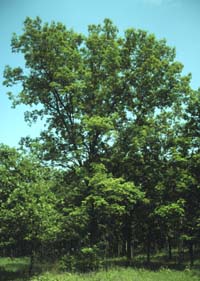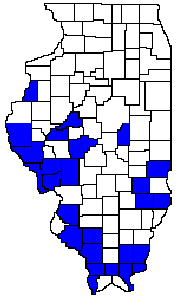 |
| Black
Hickory (Carya texana)
Distribution
Map to Right |

Black hickory (also referred to as red hickory, Texas hickory, and Buckley's hickory) is usually a small tree 25 - 50 feet in height with a trunk diameter of up to 1-2 feet. On sites with better growing conditions, the tree can attain heights of 100 feet. The crown is oblong or rounded and has relatively small branches.
Black hickory is most common west of the Mississippi. Its range, however, extends from southern Indiana into the southern parts of Illinois, through Missouri, westward to Kansas and Oklahoma, south through Arkansas to Texas and Louisiana. It typically grows on well-drained, sandy soils and on hillsides. It occasionally occurs on low, flat lands and marl soils(mixture of clays, calcium and magnesium carbonates).
In Illinois, it is present in sand forests and on dry ridges and cliffs largely along the Mississippi, Illinois and Wabash rivers the southern and western parts of the state.
Interesting
Facts
The hickories
are divided into three groups comprised of the pecans (four species), the
shagbarks (three species), and the pignuts (four species). The pignuts
are distinguished from the other groups by their tight bark (not as shaggy
as the shagbark hickory), slender twigs, thin nut husks, and smaller buds.
Black hickory is similar to pignut hickory, with its closed bark and small
buds.
Although black hickory persists in dry, nutrient-poor habitats in Illinois (sand forests, dry, gravelly ridges), its growth is stunted. Like the other hickories, black hickory is a relatively slow-growing tree with strong, resilient wood.
Identifying Features
Bark
Black hickory bark is dark brown or black, becoming fissured with age.
Twigs
The twigs are gray and typically smooth, but can have rusty colored hairs.
Buds
The buds are up to 1/2 inch long, and oval, with a short point. They are tipped with a tuft of rusty hairs.
Leaves
The leaves are alternate and pinnately compound. There are 5-7 (usually 7) lance-shaped leaflets with finely toothed edges. The leaflets are pointed at the tip, tapering toward the base, and are up to 6 inches long and less than 3 inches broad. They are dark green on the upper surface and paler and with rusty hairs on the underside. The upper surface may be either smooth or have scattered coarse hairs.
Flowers
Black hickory is moneocious (male and female flowers are borne separately, but on the same tree). Female flowers are very small, without petals and appear in groups of 1 - 2. Male flowers are clustered together in drooping catkins. Flowers appear at leafout.
Fruits
Fruits (hickory nuts) are round to egg shaped and up to 2 inches in diameter. They usually ripen in September - October. The husks typically break into 4 separate parts when the fruit is ripe. The nut husk is yellow or bronze to reddish brown, scaly, and split into four quarters nearly to the base. The seed (nut) is sweet, edible and four angled.
Uses
Black
hickory wood is heavy, elastic, and hard. It is readily attacked by insects
and decays quickly when exposed to water. It makes a very high quality
fuel, yielding high heat and high quality charcoal. It is used for fence
posts, skis, tool handles, gunstocks, and was formerly used for barrel
hoops. Swine, squirrels, opossums, and wild turkey eat the nuts. The nut
husks were once used to poison fish. This practice is illegal now. Native
Americans in Illinois ate the nuts of several of the hickory species.